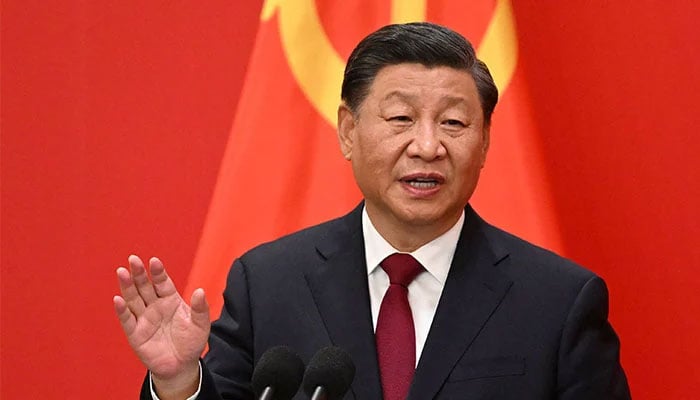China’s giant leap
The Household Responsibility System shifted agricultural production from collective farming to household-based responsibility
A gathering of some 5,000 top scientists and engineers listened in pin-drop silence on January 7, 2020 as Chinese President Xi Jinping laid out his vision and strategy to make China a world leader in a technology-driven knowledge economy.
The occasion was the conferment of the highest honour of China, the International Science & Technology Collaboration Award, which was conferred on a few scientists for their contributions to world science and for strong cooperation with China. I happened to be among those lucky few to win this prestigious award from President Xi Jinping.
The rapid socio-economic development of China since 1978 bears no parallel in human history. This huge transformation was triggered by Deng Xiaoping’s economic reforms that involved a series of transformative measures. The key steps included decentralizing economic decision-making, allowing private entrepreneurship, and introducing market-oriented reforms.
The Household Responsibility System shifted agricultural production from collective farming to household-based responsibility, thereby boosting agricultural productivity and rural incomes. Special economic zones (SEZs) were established in coastal areas to attract foreign investment and technology transfer, offering preferential policies such as tax incentives and reduced bureaucratic hurdles.
But perhaps the most important reform in China was the rooting out of corruption; it is massive corruption that has sunk Pakistan and many other developing countries in oceans of debt. President Xi launched a sweeping anti-corruption campaign in 2013, vowing to target both ‘tigers’ (high-ranking officials) and ‘flies’ (lower-level bureaucrats) in his quest to root out graft and promote party discipline.
The campaign was characterized by its high-profile arrests, investigations, and punishments of corrupt officials at all levels of government. The establishment of specialized anti-corruption bodies, such as the Central Commission for Discipline Inspection (CCDI), strengthened enforcement mechanisms and enabled more effective supervision and investigation of corrupt practices.
Exemplary punishments were given to senior government officials, highlighting the point that no one is above the law. Bo Xilai, a former member of the Politburo and party secretary of Chongqing, was one of the most prominent figures to be ensnared in Xi Jinping’s anti-corruption dragnet. Bo was convicted of bribery, embezzlement, and abuse of power in a high-profile trial in 2013. He was sentenced to life in prison, marking a significant fall from grace for a once-rising political star.
Zhou Yongkang, a former member of the Politburo Standing Committee and head of China’s security apparatus, was another major target of the anti-corruption campaign. Zhou was convicted of corruption, abuse of power, and leaking state secrets in 2015. He received a life sentence, becoming the highest-ranking official to be prosecuted for corruption since the founding of the People’s Republic of China. The crackdown on corruption has bolstered public confidence in the government and the party, demonstrating a commitment to accountability and rule of law.
Another important step to boost the national economy and promote innovation and entrepreneurship was the establishment of SEZs, starting with Shenzhen, Zhuhai, and other coastal cities. SEZs offered foreign investors favourable conditions, including tax incentives, streamlined bureaucratic procedures, and access to cheap labour. SEZs attracted foreign direct investment, facilitated technology transfer, and stimulated export-oriented manufacturing, driving China’s economic transformation and integration into the global economy.
Another important initiative of China has been the Belt and Road Initiative (BRI). It is a multifaceted infrastructure and economic development strategy aimed at enhancing connectivity and promoting economic cooperation across Asia, Africa, and Europe. It involves the construction of roads, railways, ports, and pipelines, as well as investments in energy, telecommunications, and other key sectors.
A common malaise in developing countries relates to inefficient public-sector enterprises that have become a huge burden on their economies. In Pakistan, we see how PIA, Steel Mills, Pakistan Railways and other public-sector enterprises have been eating away at national wealth due to corruption and inefficiencies.
The state-owned enterprises (SOE) reform efforts in China have focused on improving the efficiency, competitiveness, and profitability of state-owned enterprises while also reducing government intervention in the economy. Reforms included measures such as mixed-ownership reforms, where private capital is introduced into SOEs through equity partnerships or public listings, as well as restructuring and consolidation of inefficient and redundant state-owned assets.
The economy of China has also been considerably boosted by government spending on infrastructure development that encompasses a wide range of projects, including transportation networks, energy facilities, telecommunications systems, and urban infrastructure. Major initiatives include the construction of high-speed railways, expressways, airports, seaports, and hydroelectric dams, as well as investments in smart cities, digital infrastructure, and renewable energy.
The lynchpin of China’s socio-economic development has been the emphasis on education reforms and innovation. The reforms include curriculum reforms to emphasize critical thinking and problem-solving skills, expansion of vocational education and skills training programmes, and investments in educational infrastructure and technology. The government has also promoted international cooperation and exchanges to enhance educational quality and global competitiveness. These reforms have strongly supported China’s transition to a technology-driven knowledge-based economy and fostered a skilled workforce capable of driving innovation and sustainable development.
China’s emphasis on science and technology has had many important spin-offs. Lenovo is the world’s largest manufacturer of computers. BYD has overtaken Tesla in electric car manufacturing. China leads the world in the manufacture of bullet trains and in quantum computing. The country’s space exploration programme encompasses a range of missions and projects, including manned spaceflight, lunar exploration, satellite launches, and space station development. Key achievements include the launch of the Chang’e lunar missions, the Tianzhou cargo spacecraft, and the Tiangong space station.
China’s internet and information technology development involves expanding internet infrastructure, promoting digital connectivity, and fostering innovation in digital technologies and applications. The government supports the development of domestic internet companies such as Alibaba, Tencent, and Baidu, while also implementing strict internet censorship and control measures.
China’s leadership in 5G development has led to the rollout of fifth-generation wireless technology, enabling ultra-fast internet speeds, low latency, and connectivity for billions of devices. Chinese companies such as Huawei, ZTE, and China Mobile are playing pivotal roles in 5G technology development and global standards-setting, driving innovation and adoption worldwide.
China’s strategic focus on artificial intelligence (AI) development has led to it laying down ambitious goals for becoming a global leader in AI by 2030, with initiatives such as the National AI Development Plan and the New Generation AI Development Plan. China’s AI industry spans areas such as autonomous vehicles, facial recognition, machine learning, and natural language processing, driving innovation, economic competitiveness, and societal transformation in the digital age.
China is now investing heavily in the development of a quantum communication network, leveraging the principles of quantum physics to create secure communication channels. Initiatives include the development of quantum key distribution (QKD) technology, quantum satellites, and the deployment of quantum communication networks.
The writer is the former federal minister for science and technology and former founding chairman of the HEC. He can be reached at: ibne_sina@hotmail.com
-
 Why Claude Is Gaining Momentum In Revolutionizing The AI Landscape
Why Claude Is Gaining Momentum In Revolutionizing The AI Landscape -
 Cheaper Cars, Fewer EVs: Trump Administration Shifts ‘auto Policy’ Focus
Cheaper Cars, Fewer EVs: Trump Administration Shifts ‘auto Policy’ Focus -
 Meghan Markle Takes 'breadwinner' Role In Prince Harry's California Life
Meghan Markle Takes 'breadwinner' Role In Prince Harry's California Life -
 Type 2 Diabetes Hidden Trigger In Daily Food Revealed
Type 2 Diabetes Hidden Trigger In Daily Food Revealed -
 Vertical Tabs Coming To Google Chrome
Vertical Tabs Coming To Google Chrome -
 Jane Seymour Reveals THIS Beloved Romance Was 'worst-reviewed' Movie Ever
Jane Seymour Reveals THIS Beloved Romance Was 'worst-reviewed' Movie Ever -
 European Leaders Slam Trump’s Tariff Threat Over Greenland As ‘unacceptable’
European Leaders Slam Trump’s Tariff Threat Over Greenland As ‘unacceptable’ -
 Princess Eugenie Leaves Father Andrew 'devastated' With Big Step: 't's Brooklyn Beckham Level'
Princess Eugenie Leaves Father Andrew 'devastated' With Big Step: 't's Brooklyn Beckham Level' -
 Nova Scotia Snow Storm Warning Issued As Heavy Snow Moves In
Nova Scotia Snow Storm Warning Issued As Heavy Snow Moves In -
 Vancouver Canucks 2025-26 Season: Adam Foote’s Future Under Early Scrutiny
Vancouver Canucks 2025-26 Season: Adam Foote’s Future Under Early Scrutiny -
 Gabriel Diallo Vs Alexander Zverev: Rising Canadian Eyes Major Upset Opportunity
Gabriel Diallo Vs Alexander Zverev: Rising Canadian Eyes Major Upset Opportunity -
 Bo Nix Injury Update: Broncos Quarterback Fractures Ankle Against Bills
Bo Nix Injury Update: Broncos Quarterback Fractures Ankle Against Bills -
 Oilers Vs Canucks: Why Edmonton Is Without Leon Draisaitl
Oilers Vs Canucks: Why Edmonton Is Without Leon Draisaitl -
 49ers Crushed As Kenneth Walker III Leads Seahawks To 41-6 Win
49ers Crushed As Kenneth Walker III Leads Seahawks To 41-6 Win -
 Canadiens Star Lane Hutson Makes History With 100th NHL Assist
Canadiens Star Lane Hutson Makes History With 100th NHL Assist -
 Bridgerton’s Claudia Jessie Says Her Real-life Style Is Nothing Like Eloise’s
Bridgerton’s Claudia Jessie Says Her Real-life Style Is Nothing Like Eloise’s




